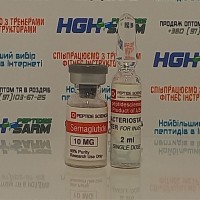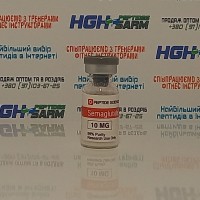Semaglutide 10 mg
- BrandsPEPTIDE SCIENCIS
- Product Code: Semaglutide 10 mg
- Availability: In Stock
-
113.52€
Semaglutide is a synthetic analogue of the glucagon-like peptide-1 receptor agonist with a modified side amino acid chain. The peptide hormone semaglutide affects processes related to the regulation of insulin secretion and is also involved in other biochemical processes in the body.
Glucagon-like peptide-1 (GLP-1) in its endogenous form is a product produced in the intestine after food consumption. The main location responsible for the production of GLP-1 is the L-cells of the small intestine, which are responsible for insulin secretion.
The beneficial properties of GLP-1 include the regulation of digestion and blood sugar concentration. Since GLP-1 is secreted when food is consumed, the small intestine is the organ responsible for this process. Its characteristic features include a reduced feeling of hunger, signals of satiety, stimulation of insulin synthesis and suppression of glucagon, and maintenance of glucose levels.
The unique properties of glucagon-like peptide-1 affecting insulin secretion have influenced the creation of drugs for the treatment of diabetes mellitus and obesity. Various types of synthetic GLP-1 receptor agonists have appeared, one of which is Semaglutide. Semaglutide was used as the basis for the creation of patented drugs for combating obesity and treating diabetes mellitus.
How does Semaglutide work?
The mechanism of action of Semaglutide is aimed at lowering blood sugar levels. This effect is achieved by enhancing the growth of pancreatic beta cells caused by the imitation of the incretin Glucagon-like peptide-1. As a result, insulin is released, followed by the release of carbohydrates from the liver and the synthesis of new glucose due to the suppression of glucagon hormone synthesis. Taking Semaglutide affects food consumption, slows down digestion, and thus affects appetite and hunger. By creating a calorie deficit through food consumption, weight loss occurs.
Chemical structure of Semaglutide:
The structure of semaglutide is highly similar to that of human GLP-1, with the main difference being the absence of the first six amino acid residues and several amino acid substitutions. These changes prevented chemical cleavage by dipeptidyl peptidase-4 and increased binding to albumin, affecting the duration of its presence in the blood. Semaglutide has a long half-life in the body, with the first signs of half-life occurring after 7 or 8 days.
Effects and properties of semaglutide:
Inhibition of gastric acid secretion
Weakened motor activity.
Increased insulin secretion by the pancreas.
Blocking of glucagon and somatostatin secretion.
Regulation of beta cell expression.
Enhanced beta cell response to glucose.
Induces beta cell proliferation and neogenesis.
Increased heart muscle contraction frequency.
Enhanced relaxation of the pulmonary muscles.
Release of thyrocalcitonin from the thyroid gland.
Effect on increased mucous secretion.
Effect on diuresis in the kidneys.
Stimulates secretion of TSH, LH, corticosteroids
Side effects of Semaglutide:
The most common side effects of Semaglutide are nausea, abdominal pain, constipation or diarrhoea, as well as vomiting, heartburn, dizziness and headache.
Semaglutide is recommended for people who are obese or have diabetes.
Tags: Semaglutide, Glucagon-like peptide-1, GLP-1 receptor agonist, GLP-1





